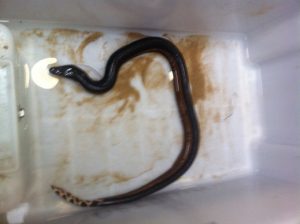
Climate Experience:
Citizen spotted a yellow-bellied sea snake, a species not usually found in cold Victorian waters.
Explanation:
- The East Australian Current has extended 350kms south since the 1940s, increasing Victorian water temperatures, enabling warmer water species to migrate further south.[1]
- Sea-surface temperatures have warmed nearly 1 degree since 1900.[2]
- Victorian waters are increasing temperatures faster than anywhere else in Australia.[3]
- Southern Australian sea surface temperatures have been above the average for the past 26 consecutive years.[4]
- Australian sea surface temperatures have been above average for 36 of the past 40 years.[5]
Ramifications:
- Changes have the potential to profoundly alter temperate sea-life communities with cascading effects for the biodiversity and function of coastal ecosystems.[6]
- Kelp forests will continue to be even more under threat going into the future.[7]
What can be done?
- Email your local MP and tell them that action on climate is important to you and explain the impacts being felt in your area. One email might not feel like much but most politicians consider it to be representative of 100 citizens.
- Help support the Act on Climate collective by donating; we are leading the charge for climate action. Your donation helps in advancing policies that prevent climate change from getting worse, we aim to empower communities and build a strong pro-climate-action constituency that governments can’t ignore, and as an added bonus it’s tax-deductable.
- Get involved with Act on Climate. We meet every Monday at 6pm (upstairs at 312 Smith St, Collingwood) and welcome all newcomers to join in the fight for climate justice. If you are unable to attend, follow us on Facebook, Twitter and Instagram to keep up with the latest campaign.
* We aim to keep our material as accurate and as relevant as possible. Working with climate science, a field that is being constantly updated, keeps us on our toes. Information on this site was gathered on June 1 2019; if you notice information that needs updating please let us know. For the full reference list please see the following.
______________________________
[1]Ridgway and Hill, “The East Australian Current.”1.
[2]“Australian climate trends,” Climate change in Australia, updated February 16, 2018, https://www.climatechangeinaustralia.gov.au/en/climate-campus/australian-climate-change/australian-trends/
[3]“Climate change – trends and extremes: trends map,” Bureau of Meteorology, access April 29, 2019, http://www.bom.gov.au/climate/change/#tabs=Tracker&tracker=trend-maps&tQ=map%3Dsst%26area%3Daus%26season%3D0112%26period%3D1980
[4]“Climate change – trends and extremes: time series graph,” Bureau of Meteorology, access April 29, 2019, http://www.bom.gov.au/climate/change/#tabs=Tracker&tracker=timeseries&tQ=graph%3Dsst%26area%3Dsth%26season%3D0112%26ave_yr%3D0
[5]“This summer’s sea temperatures were the hottest on record in Australia: here’s why,” Bureau of Meteorology, access April 29, 2019, http://www.bom.gov.au/climate/updates/articles/a015.shtml
[6]Vergés et al., “The Tropicalization of Temperate Marine Ecosystems: Climate-Mediated Changes in Herbivory and Community Phase Shifts.”8.
[7]Doug Struck, “Tropical fish cause trouble as climate change drives them toward the poles,” National Geographic, published July 24, 2014, https://news.nationalgeographic.com/news/2014/07/140725-climate-change-tropical-fish-animals-ocean-science/
